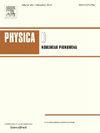平流主导动力系统的神经常微分方程模型中潜在时间尺度的理解
IF 2.9
3区 数学
Q1 MATHEMATICS, APPLIED
引用次数: 0
摘要
近年来,神经常微分方程(ODE)框架在开发以偏微分方程(PDEs)为特征的复杂物理系统的高加速代理模型方面显示出相当大的前景。对于基于pde的系统,最先进的神经ODE策略利用两步过程来实现这种加速:由自动编码器提供的非线性降维步骤,以及由基于神经网络的模型提供的时间积分步骤,用于生成潜在空间动力学(神经ODE)。这项工作探讨了这种基于自编码器的神经ODE策略在平流项起关键作用的偏微分方程中的适用性。更具体地说,除了预测性演示,对模型加速来源的物理洞察(即神经ODE如何实现其加速)是当前研究的范围。这些研究是通过使用动态系统雅可比矩阵的特征值分析来量化自编码器和神经ODE组件对潜在系统时间尺度的影响来进行的。为此,对各种关键训练参数的敏感性进行了量化,例如解耦与端到端训练、潜在空间维数和训练轨迹长度对模型精度和发现的潜在系统时间尺度的影响。这项工作特别揭示了训练轨迹长度(训练过程中损失函数中的推出步骤数)在潜在系统时间尺度上所起的关键作用:较大的轨迹长度与极限神经ODE时间尺度的增加相关,并且发现最优神经ODE可以恢复全阶(ground-truth)系统的最大时间尺度。在平流影响下的不同非定常流体动力学配置中进行了演示:(1)Kuramoto-Sivashinsky方程;(2)氢-空气通道爆轰(具有详细化学的可压缩反应Navier-Stokes方程);(3)二维大气流动。本文章由计算机程序翻译,如有差异,请以英文原文为准。
Understanding latent timescales in neural ordinary differential equation models of advection-dominated dynamical systems
The neural ordinary differential equation (ODE) framework has shown considerable promise in recent years in developing highly accelerated surrogate models for complex physical systems characterized by partial differential equations (PDEs). For PDE-based systems, state-of-the-art neural ODE strategies leverage a two-step procedure to achieve this acceleration: a nonlinear dimensionality reduction step provided by an autoencoder, and a time integration step provided by a neural-network based model for the resultant latent space dynamics (the neural ODE). This work explores the applicability of such autoencoder-based neural ODE strategies for PDEs in which advection terms play a critical role. More specifically, alongside predictive demonstrations, physical insight into the sources of model acceleration (i.e., how the neural ODE achieves its acceleration) is the scope of the current study. Such investigations are performed by quantifying the effects of both autoencoder and neural ODE components on latent system time-scales using eigenvalue analysis of dynamical system Jacobians. To this end, the sensitivity of various critical training parameters – de-coupled versus end-to-end training, latent space dimensionality, and the role of training trajectory length, for example – to both model accuracy and the discovered latent system timescales is quantified. This work specifically uncovers the key role played by the training trajectory length (the number of rollout steps in the loss function during training) on the latent system timescales: larger trajectory lengths correlate with an increase in limiting neural ODE time-scales, and optimal neural ODEs are found to recover the largest time-scales of the full-order (ground-truth) system. Demonstrations are performed across fundamentally different unsteady fluid dynamics configurations influenced by advection: (1) the Kuramoto–Sivashinsky equations (2) Hydrogen-Air channel detonations (the compressible reacting Navier–Stokes equations with detailed chemistry), and (3) 2D Atmospheric flow.
求助全文
通过发布文献求助,成功后即可免费获取论文全文。
去求助
来源期刊

Physica D: Nonlinear Phenomena
物理-物理:数学物理
CiteScore
7.30
自引率
7.50%
发文量
213
审稿时长
65 days
期刊介绍:
Physica D (Nonlinear Phenomena) publishes research and review articles reporting on experimental and theoretical works, techniques and ideas that advance the understanding of nonlinear phenomena. Topics encompass wave motion in physical, chemical and biological systems; physical or biological phenomena governed by nonlinear field equations, including hydrodynamics and turbulence; pattern formation and cooperative phenomena; instability, bifurcations, chaos, and space-time disorder; integrable/Hamiltonian systems; asymptotic analysis and, more generally, mathematical methods for nonlinear systems.
 求助内容:
求助内容: 应助结果提醒方式:
应助结果提醒方式:


